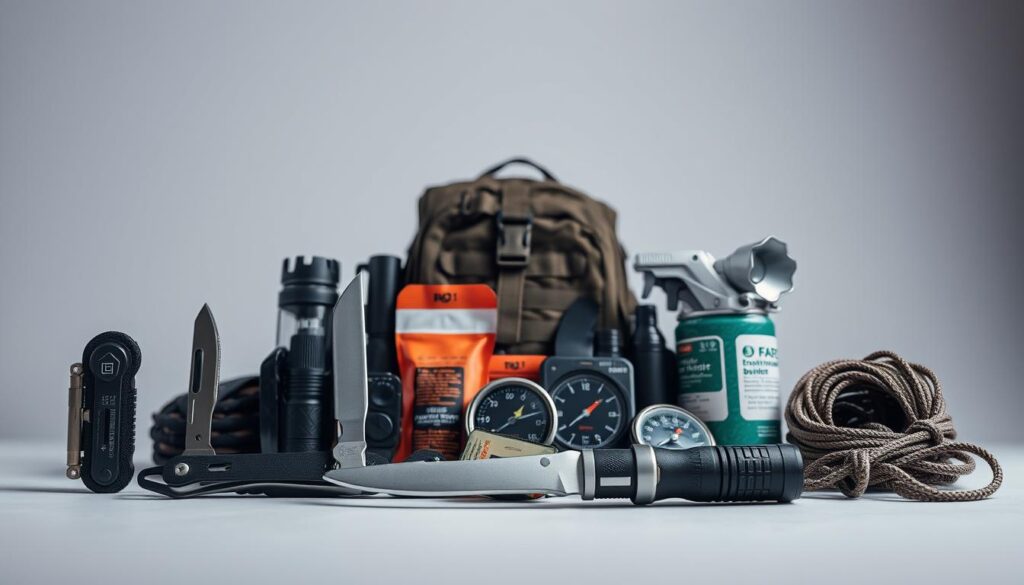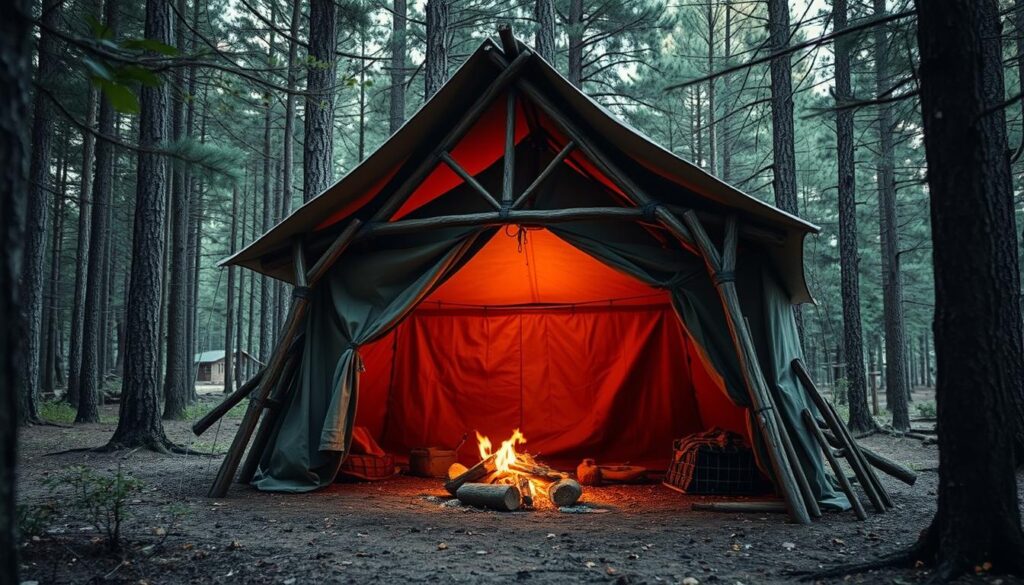Being ready for the unexpected is key in our lives. A well-stocked emergency shelter kit can be a lifesaver in tough times.
I once found myself in a tough spot, but the right supplies helped me get through. A disaster supplies kit is packed with must-haves for surviving days on end.
In this guide, I’ll show you what makes up a disaster relief kit. You’ll learn how to be ready for anything that comes your way.
Key Takeaways
- Understand the importance of having an emergency shelter kit.
- Learn the essential components of a disaster supplies kit.
- Discover how to prepare for emergencies with the right survival gear.
- Be prepared to survive for several days with a well-stocked kit.
- Gain confidence in facing unexpected situations.
Why an Emergency Shelter Kit is Essential
An emergency shelter kit is very important, more so in areas prone to natural disasters. When I prepare for emergencies, knowing the risks and having the right shelter supplies is key.
It’s important to know the types of natural disasters that could hit my area. This includes hurricanes, earthquakes, floods, or wildfires. Each disaster needs a different emergency plan.
Understanding Natural Disasters
Natural disasters can happen without warning. It’s critical to be ready. For example, hurricanes bring strong winds and lots of rain. Earthquakes can cause a lot of damage and landslides.
Assessing Risks in My Area
Figuring out the risks in my area means knowing the disasters I might face and how they could affect me. This helps me make my outdoor survival shelter and emergency kit fit my needs.
| Disaster Type | Primary Risks | Shelter Requirements |
|---|---|---|
| Hurricanes | Strong Winds, Flooding | Wind-resistant shelter, flood protection |
| Earthquakes | Structural Damage, Landslides | Earthquake-resistant shelter, emergency supplies |
By knowing these risks and preparing, I can make sure my emergency shelter kit works well. This boosts my emergency preparedness.
Key Components of an Emergency Shelter Kit
It’s important to know what makes up a good emergency shelter kit.
Shelter Materials
The base of any emergency shelter kit is the shelter materials. These include tents, tarps, and plastic sheeting. They keep you safe from the weather.
A good tent is waterproof, strong, and easy to put up. Tarps and plastic sheeting can also help, adding extra protection from rain and wind.
Sleeping Gear
Having the right sleeping gear is key for staying warm and getting a good night’s sleep. You’ll need sleeping bags, sleeping pads, and blankets.
Choose sleeping bags that match the temperature you’ll face. Sleeping pads add comfort and keep you warm from the ground.
Cooking Supplies
Cooking supplies are important for making food and purifying water. You’ll need portable stoves, cooking pots, and utensils.
Portable stoves are reliable for cooking. Cooking pots and utensils help you prepare meals.
| Component | Description | Importance Level |
|---|---|---|
| Shelter Materials | Tents, Tarps, Plastic Sheeting | High |
| Sleeping Gear | Sleeping Bags, Sleeping Pads, Blankets | High |
| Cooking Supplies | Portable Stoves, Cooking Pots, Utensils | Medium |
Choosing the Right Location for My Shelter
To stay safe, I must pick a good spot for my emergency shelter.
I look for safe places and think about what might affect my shelter’s success.
Evaluating Safe Spaces
When picking a spot, I check the terrain and look out for dangers. I want to avoid places that might flood or slide.
The area should be flat and dry. This makes my shelter more comfortable and stable.
Factors to Consider for Location
There are key things to think about when choosing a shelter location. These include how close it is to dangers, how easy it is to get to, and if there are resources nearby.
- Proximity to Hazards: I steer clear of areas near water, steep slopes, or industrial sites.
- Accessibility: The spot should be easy to get to. This helps me reach it fast in an emergency.
- Resource Availability: It’s good to be near water and have building materials nearby.
| Factor | Consideration | Importance Level |
|---|---|---|
| Proximity to Hazards | Avoid areas prone to natural disasters or industrial hazards. | High |
| Accessibility | Ensure the location is easily reachable. | High |
| Resource Availability | Proximity to water sources and building materials. | Medium |
By carefully looking at these points, I can pick a safer spot. This boosts my emergency preparedness and makes my outdoor survival better.
The best spot for my shelter is safe, easy to get to, and has resources. This makes my portable emergency shelter work better.
Basic First Aid Supplies to Include
A first aid kit is key for any emergency shelter kit. It helps me deal with medical emergencies. I must think about the injuries or illnesses that might happen during a disaster.
The kit should have both essential medications and first aid tools. This makes sure I’m ready for many medical situations.
Essential Medications
Medications are a must in my first aid kit. These include:
- Over-the-counter items like pain relievers, antihistamines, and anti-diarrheal meds.
- Prescription drugs I or my family might need, with dosage lists.
- Special equipment like EpiPens or inhalers for certain health issues.
It’s smart to have a first aid guide too. It helps me know how to treat emergencies right.
First Aid Tools and Equipment
My first aid kit also needs first aid tools and equipment. These are:
- Bandages and band-aids in different sizes.
- Antiseptic wipes and ointments to stop infections.
- Gauze pads and rolls for wound care.
- Medical tape to keep bandages in place.
- Scissors and tweezers for cutting or removing splinters.
Having these items ready helps me treat injuries fast. It lowers the chance of infection and aids in healing.
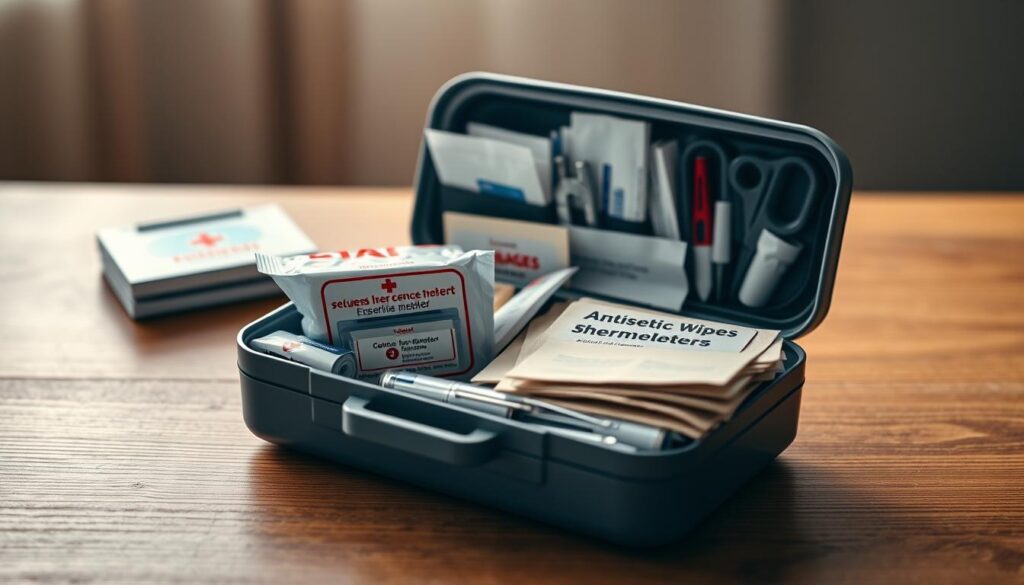
Having a well-stocked first aid kit is vital for emergency survival. It’s a key part of my disaster relief kit. It prepares me for many medical emergencies during a disaster.
Food and Water Considerations
In an emergency, having food and clean water is key to survival. As I put together my emergency shelter kit, I focus on these basic needs.
It’s important to have non-perishable food on hand. These foods last a long time without refrigeration. They give us the energy we need during tough times.
Non-Perishable Food Options
When picking food for my emergency kit, I choose items that are both durable and nutritious. Here are some good options:
- Canned goods such as vegetables, fruits, and meats
- Dried legumes like beans and lentils
- Nuts and dried fruits for a quick energy boost
- Ready-to-eat meals like MREs (Meals Ready to Eat)
Ready-to-eat meals are easy to use and add a lot to an emergency food supply. A disaster relief expert says, “Having a stockpile of ready-to-eat meals can make a big difference in survival and comfort during emergencies.”
“In disaster scenarios, having access to clean water is as critical as food. Methods for purifying water are essential components of an emergency shelter kit.”
Water Purification Methods
Having clean drinking water is just as important as food. There are many ways to purify water, making it safe to drink. Here are a few:
- Using water filters, such as portable filter units or personal filtration bottles
- Employing water purification tablets or bleach to kill bacteria and viruses
- Boiling water, which is a simple yet effective method to purify water
By adding non-perishable food and water purification methods to my emergency shelter kit, I can meet my basic needs during a crisis.
Tools and Equipment for Building Shelter
Having the right tools and equipment is key for building an emergency shelter. As I prepare for emergencies, I focus on the essential items for a safe shelter.
In previous sections, we talked about the importance of a well-rounded emergency kit. Now, let’s look at the tools and equipment needed for a shelter. The right emergency camping equipment is vital in survival situations.
Multi-tools and Knives
Multi-tools and knives are essential for any shelter supplies kit. A multi-tool can handle tasks like cutting branches and opening cans. I make sure my multi-tool is sturdy and versatile.
A knife is key for precise tasks, like cutting rope or whittling wood. I prefer a knife with a fixed blade for its durability and reliability.
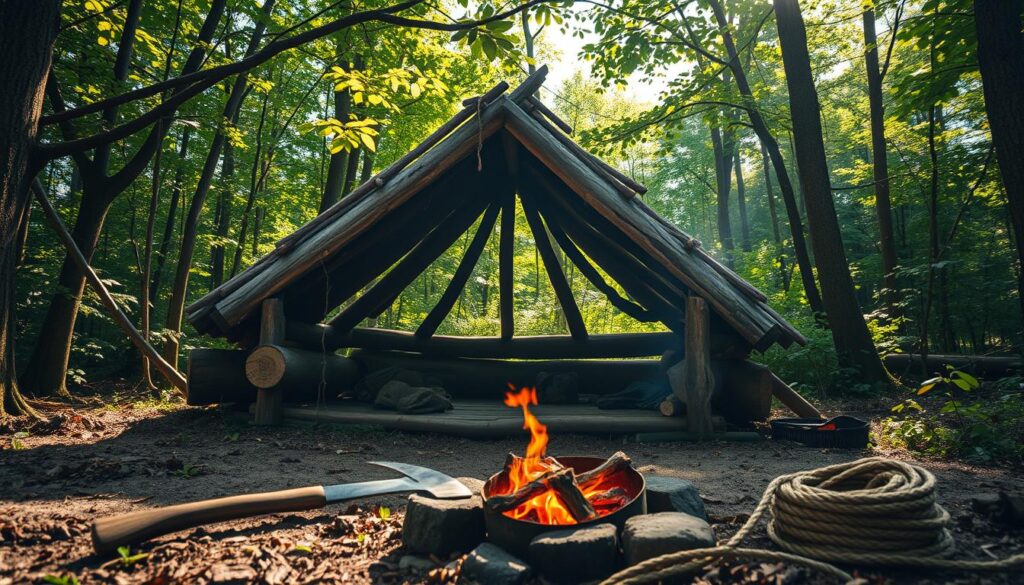
Tarps and Ropes
Tarps and ropes are critical for outdoor survival shelter equipment. A tarp offers a waterproof layer for my shelter, keeping me dry. I choose tarps made from durable, waterproof materials.
Ropes are needed to secure the tarp to trees or other stable structures. I use ropes made from nylon or polyester, as they resist rot and weathering.
By adding these essential tools and equipment to my emergency kit, I’m ready to build a safe shelter in a survival situation.
Safety and Security Measures
Safety and security are key in any emergency plan. When I prepare my emergency shelter kit, I focus on safety and security. This ensures my well-being in crises.
Emergency Lighting Solutions
Reliable emergency lighting solutions are essential. This includes:
- Flashlights with extra batteries
- LED candles or solar-powered lights
- Glow sticks for extra light
These lights not only light up but also help signal for help if needed.
Communication Devices
Effective communication devices are vital for staying in touch. Some key devices are:
- A fully charged cell phone with a backup power source, like a portable charger or solar charger
- A two-way radio or walkie-talkie for talking to family or team members
- A whistle to signal for help in emergencies
These devices help me communicate well during emergencies. This boosts my safety and security.
By adding these safety measures to my emergency kit, I can greatly improve my safety in emergencies.
Planning for Personal Hygiene
My emergency shelter kit is not complete without personal hygiene supplies and a plan for waste disposal. Keeping clean is key in emergencies to stop diseases and stay healthy.
Basic Hygiene Supplies
Basic hygiene items are a must in my emergency kit. I include toilet paper, hand sanitizer, and biodegradable soap. Toilet paper is essential, and hand sanitizer is great when water is hard to find. Biodegradable soap is good for both cleaning and personal hygiene and is eco-friendly.
I also pack moist towelettes and garbage bags for cleanliness and waste control. Moist towelettes are handy when water is not around, and garbage bags keep waste in check.
Waste Disposal Methods
Good waste disposal is vital in emergencies to avoid disease spread. I include a portable toilet or a cathole trowel in my kit. A portable toilet is a clean way to handle waste, and a cathole trowel is for digging a hole for waste outside.
It’s also key to dispose of waste properly. I bury human waste at least 200 feet from water and campsites. I have a plan to manage waste safely for myself and the environment.
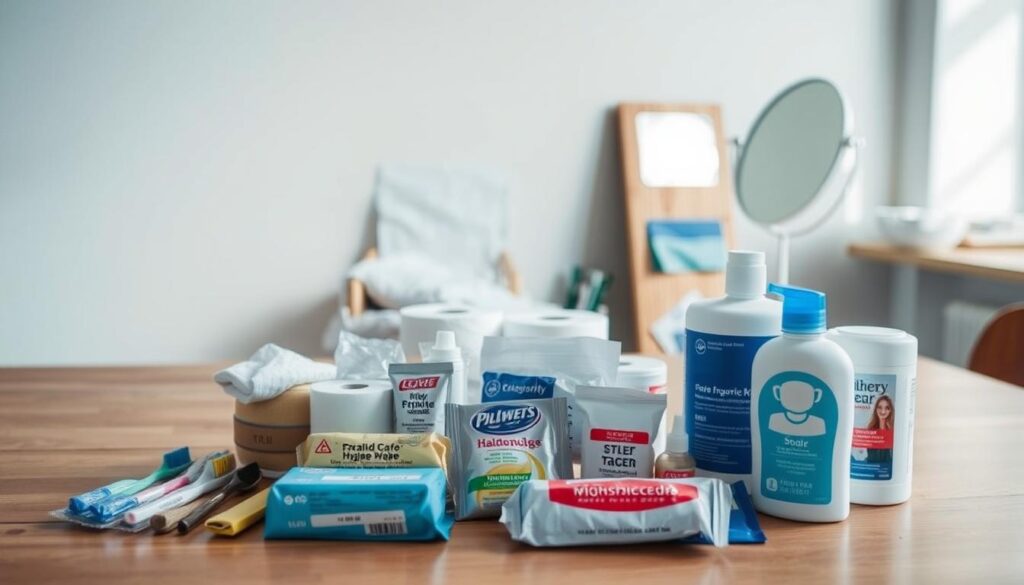
Financial Preparedness for Emergencies
Being financially ready for emergencies is a big part of my emergency plan. It’s not just about saving money. It’s also about knowing how to use my resources for emergency kits and finding financial help when needed.
Budgeting for Emergency Kits
Setting a budget for my emergency kit means I have to choose what’s most important. I need to think about the cost of food that won’t spoil, water purification tablets, and a first aid kit. By figuring out these costs, I can handle my spending better.
Here’s a simple breakdown of estimated costs for emergency kit components:
| Item | Estimated Cost |
|---|---|
| Non-perishable food (1 week supply) | $50 |
| Water purification tablets/filter | $20-$100 |
| First aid kit | $50-$100 |
| Communication device (e.g., battery-powered radio) | $20-$50 |
| Total Estimated Cost | $140-$300 |
Potential Grants or Aid Programs
There are many government and non-profit programs that help people in emergencies. For example, FEMA helps those affected by disasters.
To get help from these programs, I need to know how to apply. I must have my important documents ready, like insurance, ID, and proof of where I live.
Practicing Emergency Scenarios
Emergency preparedness is more than just having a kit. It’s also about practicing for emergencies. This practice ensures I can respond well in a disaster.
Conducting Drills
Drills are key to emergency preparedness. They let me practice setting up my emergency shelter kit. I get to know my equipment and tools better.
- Practice setting up my shelter quickly and efficiently.
- Test the durability and functionality of my shelter materials.
- Ensure that I can operate all tools and equipment safely.
Role-Playing for Preparedness
Role-playing different emergency scenarios boosts my preparedness. It helps me think critically and respond effectively in various disasters.
- Simulate different types of emergencies, such as earthquakes or hurricanes.
- Practice communicating with family members or emergency services.
- Test my decision-making skills under pressure.
By doing drills and role-playing, I make sure I’m ready for many disasters. This approach strengthens my emergency preparedness plan.
Keeping My Emergency Kit Updated
I need to check my emergency shelter kit often to keep it ready. I check the expiration dates of supplies, update personal documents, and check the condition of shelter supplies.
Regular Checks and Updates
I should check my emergency kit at least twice a year. I replace expired items and update it for my family’s changing needs. I also make sure all shelter supplies are in good shape.
For more tips on keeping an emergency kit, I can visit Ready.gov. They have advice on storing food, water, and other key items.
Regularly checking and updating my emergency kit helps it stay ready for emergencies.
FAQ
What is the most essential item to include in my emergency shelter kit?
A reliable shelter material, like a tent or tarp, is key. It keeps you safe from the weather.
How do I choose the right location for my emergency shelter?
Look for a spot that’s safe from hazards and easy to get to. It should also have water and food nearby. Avoid places that might flood or slide.
What are the most important first aid supplies to include in my emergency shelter kit?
You’ll need bandages, antiseptic wipes, and pain relievers. Don’t forget your personal meds. Also, include tools like tweezers and scissors.
How can I ensure access to safe drinking water in an emergency situation?
Add water filters or purification tablets to your kit. A portable water container or hydration bladder is also a good idea.
What tools and equipment are necessary for building and maintaining an emergency shelter?
You’ll need multi-tools, knives, tarps, and ropes. These help you build a strong and safe shelter.
How can I maintain personal hygiene during an emergency?
Pack basic hygiene items like toilet paper and hand sanitizer. Don’t forget biodegradable soap. Also, think about how to dispose of waste.
How often should I check and update my emergency shelter kit?
Check your kit often to make sure it’s up to date. Look at expiration dates and update personal documents. Do a full inventory check too.
What are some non-perishable food options I can include in my emergency shelter kit?
Include energy bars, canned goods, and dried fruits and nuts. A portable stove or camping cookware can help you prepare meals.
How can I stay safe and secure during an emergency?
Add emergency lighting like flashlights or glowsticks. Also, include communication devices, such as cell phones or two-way radios.
How can I budget for emergency preparedness?
Set aside money each month for emergencies. Look for grants or aid programs that can help with emergency prep.
Why is it important to practice emergency scenarios?
Practicing drills and exercises boosts your readiness. It ensures you and your family know how to act in emergencies.

